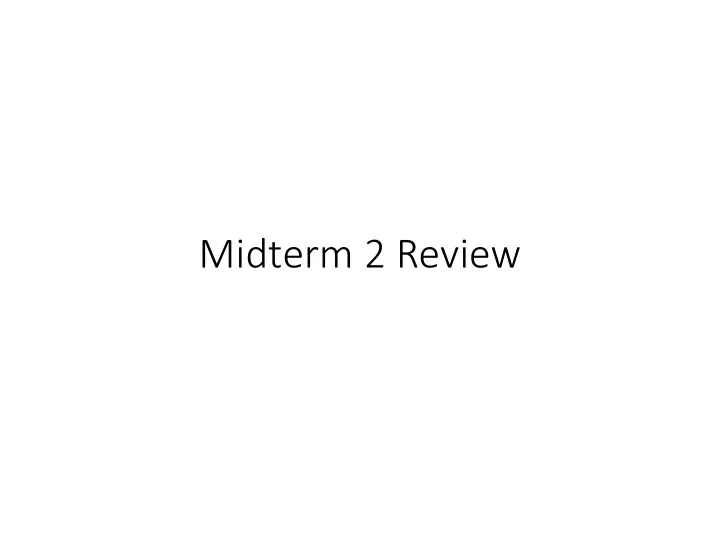

Midterm 2 Review
Midterm Topics • Leader Election • Consensus • Formulation • Synchronous consensus • Paxos • FLP Theorem • Bitcoin • Raft • DHT
Midterm Format • Timed exam, 7–9 p.m. Monday • Exam released @ 7 p.m. • Upload your answers to Gradescope by 9 p.m. • Typed file strongly preferred • Scanned handwritten solutions accepted in a pinch • Open book but no collaboration (honor code) • Zoom meeting (office hour) for clarifications • Google Doc for shared clarifications
Leader Election • Goal: elect a single leader • Upon detecting current leader failure • Tolerate multiple elections • Pick leader based on attribute • Properties • Safety: each process considers the unique live process with highest ID new leader • Liveness: a leader is eventually elected
Leader Election Algorithms • Ring • Send election message around the ring • Keep track of highest ID seen • If highest seen ID = mine, consider self elected • One more trip around to tell everyone else • Bully • Send messages to all processes with higher IDs • If none respond (timeout) consider self elected • Otherwise, those processes start election themselves
Consensus • Each process has some input value x i value and output value y i • Goal: all processes agree on some output value • Once output is set, process is in decided state, output cannot change • Properties: • Termination: Each (correct) process reaches decided state • Agreement: If two correct processes p i and p j reach decided state, their outputs must match, y i = y j • Integrity: If all processes have the same input, they must use it as the output: x i = x j for all i, j => x i = y i
Synchronous Consensus Tolerates up to f failures • Round 1: B-multicast value to all other processes • Round 2…f+1: B-multicast all [newly] received values to all other processes • Decision: pick smallest of all received values Intuition: after a failure-free round, all processes have the same set of values
FLP Theorem Impossible to have totally correct consensus in asynchronous systems • Important since consensus is equivalent to many other things • Leader election • Totally ordered multicast • … • In practice: design so that guarantees are met if communication delay within a bound • Otherwise, give up on liveness (eg. Paxos, Raft) or safety
FLP Model • Configuration: state of all processes + message buffer • Initial configuration: processes’ inputs + all initial messages • Event • Deliver a message from message buffer to one process • Update state & generate new messages • Schedule: sequence of events • Model: all messages eventually delivered but can be arbitrarily delayed, reordered • Configurations: • 0-Valent: result in decision of 0 • 1-Valent: result in decision of 1 • Bivalent: can result in either decision
FLP Proof Steps Lemma 1: Schedules that involve non-overlapping processes commute Lemma 2: There exists a bivalent initial configuration Lemma 3: From a bivalent configuration, another bivalent configuration is always reachable Conclusion: there is an infinite path of bivalent configurations, i.e., never reaches decision => liveness not satisfied [despite all messages being eventually delivered]
Paxos: Consensus Protocol Phase 1: Phase 2: • Proposer sends a prepare request • If majority of acceptors reply, with a proposal # proposer sends accept request • Value = highest among replies from • Acceptor replies with: acceptors • Promise not to reply to proposals • Acceptor accepts proposal if would with lower # not violate promise • Promise not to accept proposals with lower # • Signals acceptance to learners • # and value of highest # proposal Learners: accepted • No reply if would violate previous • Decision reached once majority of promise acceptors accept the same value
Log consensus • State machines: some process state that gets updated in response to events • Replicated state machines • Maintain availability / durability if some processes fail • Log consensus: agree on exact sequence of events/updates that get applied • Log consensus + deterministic state machines => consistent replicated state machines
Raft consensus Leader election Log replication • Started when leader heartbeat • Leader acts as sequencer for timeout expires (randomized) events • Starts a new term • Replicates events to followers A node votes for the leader if • Event replicated by a majority of followers can be committed • Has not voted for anyone else in same term Log consistency • Candidate’s log is up to date • Logs of followers get overwritten to match leader’s log Majority votes: candidate elected • Majority restriction + up-to-date- Split elections possible, term check: committed entries never get incremented overwritten
Bitcoin / Blockchain Designed for log consensus among Block creation: large-scale, dynamic groups • Decentralized “leader election” Transaction ordering: by solving verifiable puzzle • Difficulty tuned to limit block • Group transactions into blocks creation rate • Chain blocks using hash • Chain split / forks possible, but functions long-lived forks unlikely Gossip-based broadcast • k-deep transactions are • Transactions / blocks gossiped to considered committed random neighbors • E.g., k=6 • Viral spread across the network
Recommend
More recommend